GCPP:Proposal-Grouper
Puzzle Codename: Grouper
| Contact | |
| Username: | Redlucy |
| Additional contact info: | redscourger@gmail.com |
| Project forum thread: | [1] |
Game concept
A puzzle game with circular movement emulating a hammer forcing metal particles toward a center point.
Objective
To push items/metal particles to a center point and complete a series of recipes.
Gameplay
In the center of the play area, a large circle represents the cross section of a metal rod. Suspended on a set of concentric circles are small particles of different kinds of metal. The player has the options of hammering, and turning. A hammer blow will move all the pieces on the board one space either toward or away from the center, depending upon their relative position in the board. (See image for motion directions) Turning will advance all pieces one space counter clock wise.
New pieces are randomly added to the edge of the board as old pieces are either brought to the center, or hammered off the edge.
New pieces are always hot, and cool over time. If all the pieces in a puzzle become cold, the rod will be re-set with all hot pieces in a random formation.
Each metal has a bright/hot state, a middle warm state, and a dark/cool state.
Iron: ![]()
![]()
![]()
Carbon: ![]()
![]()
![]()
Below the rod is a set of three recipes, and any pieces which have been hammered to the center, but not yet used to make up a recipe. When one of the recipes is matched a new (random) one will appear. The recipes show bisected versions of the metal pieces, indicating that they can be filled by either hot or cold metal.
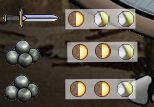
Gameplay scenario:
Johnnypirate50 decides to check out the iron monger puzzle. He has read the tutorial, so he knows that he is trying to fill recipes, which will be displayed in the lower left of the game screen. The game screen loads and Johnnypirate50 sees the playboard, with several pieces of hot metal scattered around it.
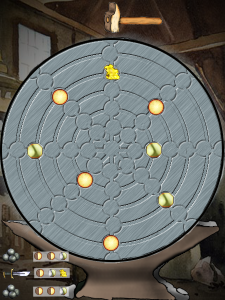
Johnny knows that hot metal is worth more than cold metal, and he sees that there is a carbon piece close to the center. All the recipes on his board have carbon in them, so he decides to get that piece into the middle. He was a little confused about how the pieces move on the board, but he knows that the top center line of pieces will move toward the center if he hammers them, so he rotates the board twice (it moves in a counter-clockwise direction) until the carbon piece he is after is located directly below the hammer.
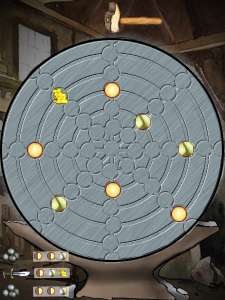
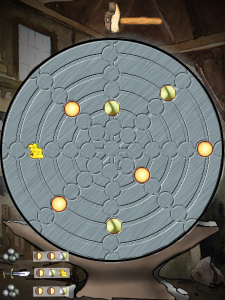
Once the carbon piece Johnny had his eye on is under the hammer, he hammers twice to drive it to the center.
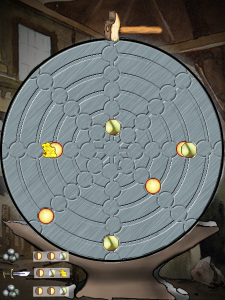
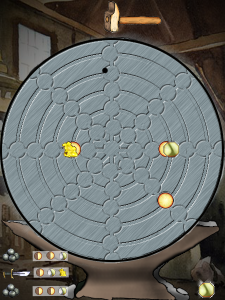
The carbon piece shines when it reaces the center of the board, and then disappears. Johnny notices that there is now a piece in the lower right of his game screen; he assumes (correctly) that this is the piece he has just hammered through the center. Johnny also notices that a few of his metal pieces have fused; they now travel together. There are a few pieces which have been hammered off the bottom of the board. They also disappear, and will be counted against Johnny's final score.
Johnny sees that none of his recipes call for two carbon. The sword blade can be completed with one iron and one sulfur, while the two cannon ball recipes each need two iron. One of the iron pieces left on Johnny's board is now fused to a carbon, so he decides to focus on the other two. He isn't sure if he should go for the single iron piece or the one that is fused to a sulfur. He starts to turn the board while he decides.
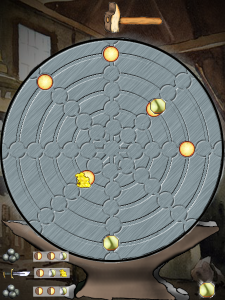
After turning the board one move, Johnny notices that he has new pieces. He dropped two pieces off the board, and made one piece go into the center. There are now three new pieces at the edge of the board, so Johnny assumes that he will get a new piece for every piece that leaves the board. (Johnny is only partially right here. As he gets better with Iron Working, he will get more randomized numbers of new pieces.) Johnny also notices that he doesn't have any new sulfur pieces. There is a piece of iron under his hammer, but he decides that he doesn't want to lose his only sulfur piece without finishing a sword blade. He continues to rotate the board until the fused sulfur is under his hammer. (This takes several turns, so I will only include pictures of the first and last rotation.)
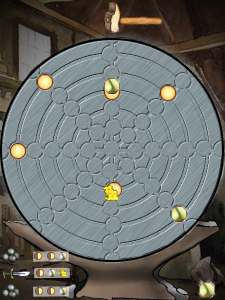
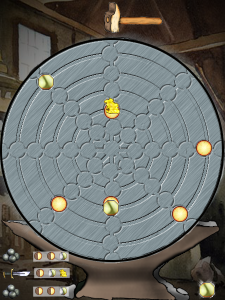
Once the sulfur is where he knows he can hit it, Johnny swings the hammer to bring the sulfur towards the center.
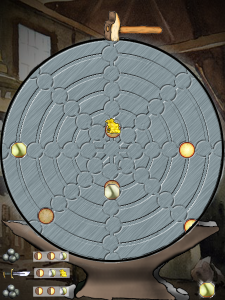
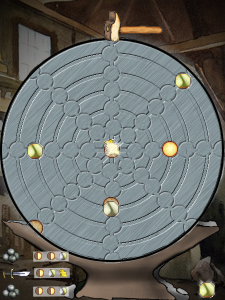
Johnny notices that when he hammers this time, several of his pieces get darker. This means that they are starting to cool, and he will not recieve as many points for them. The newest pieces remain hot.
Once again, when a piece reaches the center, it glows and disappears. There is also a new hot piece on the board for the one that got hammered off the bottom. (There is another piece which got hammered out this time, and it will be replaced when Johnny makes his next move.) This time, when the center pieces appear in the lower right, one of the recipes is highlighted -- Johnny has completed that recipe. (The first carbon piece and the fused iron and sulfur complete the iron/carbon/sulfur sword blade recipe.) The filled recipe then disappears (as do the pieces in the lower right), any recipes above it drop down, and a new recipe is added to the top.
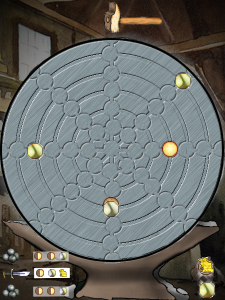
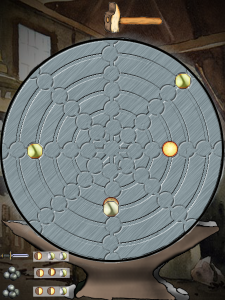
Johnny has noticed that, while pieces directly to the left or right of his hammer move around their rings, and away from his strikes, the pieces on the horozontal lines move toward the center. He decides to try hammering without turning the board.
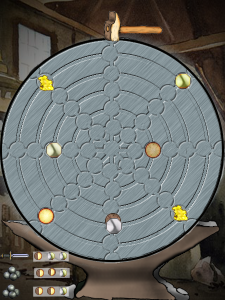
The horozontal pieces do move into the center, as Johnny expected. New hot pieces appear at the edges of the board, and older pieces cool down.
Just to see what will happen, Johnny decides to hammer the sulfer, which is not called for in any of his current recipes, to the center. The sulfur piece shines and appears in the lower right, just like the earlier pieces did. Johnny then follows by adding two carbon pieces to the center. An unpleasant sound plays, the pieces disappear, and none of the recipes are affected. Johnny loses a few points, as if those pieces had fallen off the edge, and he starts working on a new recipe.
Scoring
Each hot metal piece which goes toward filling a recipe is worth 3 points. A warm piece is worth 2, and a cold piece is worth 1.
Each piece which is hammered off the board, or into the center in such a way that it does not fill a recipe will cause a 1 point deduction.
A fused piece will gain 1 point for each piece beyond one which goes toward filling a recipe. If a fused piece has more metal than is needed to fill any one recipe, all the fused elements are counted individually as pieces which do not fill the recipe. (A three element fused piece which matches a recipe is worth a 2 point addition to whatever the individual elements are worth. If it does not fill any recipe, that same three element fuse is worth a 3 point deduction, the same deduction that would have been given had all three pieces been moved to the center individually.)
If no move has been made within a certain time, the rod resets and a 7 point deduction is made.
Variability
The metal pieces which the player begins with will be randomized, as will the pieces which enter from the outside ring as the game progresses.
End criteria
The end of an hour's labor is achieved when a certain number of recipes have been completed.
Difficulty scaling
The recipes may get more complex as the player improves. Different kinds of rare metals may also be added at the higher levels. More pieces are added to the edge of the board when old pieces are removed through recipe completion or being hammered off the edge. (This means that there are more fresh hot pieces, more potential for fused pieces, but also a greater chance of pieces being hammered off the board.)
Crafting type
Conceived around Blacksmithing. If anyone sees a way to open it to other crafting types, it can be modified to fit that vision.
Known problems
No way of doing long combo chains
Notes
Guybrush graciously agreed to assist with graphics.
Images
Redlucy's attempt to describe paths of motion for hammered pieces.
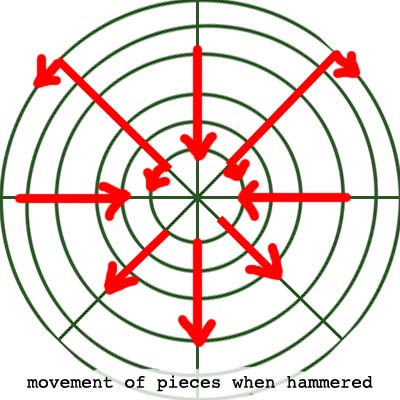
Guybrush's Amazing Gameboard
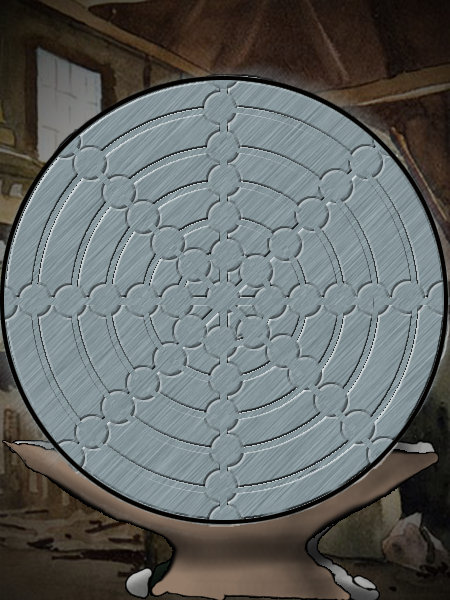
Hammer image, by Guybrush.
